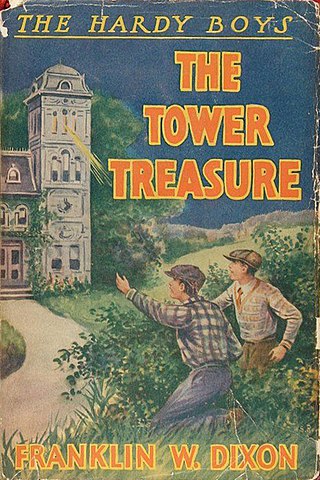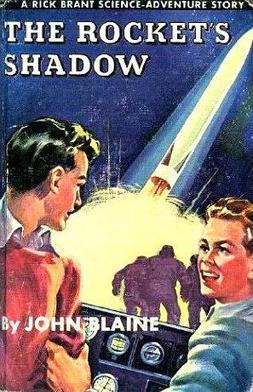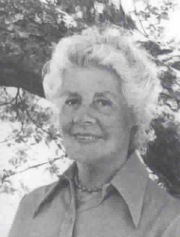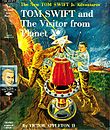
Nancy Drew is a fictional character appearing in several mystery book series, movies, video games, and a TV show as a teenage amateur sleuth. The books are ghostwritten by a number of authors and published under the collective pseudonym Carolyn Keene. Created by the publisher Edward Stratemeyer as the female counterpart to his Hardy Boys series, the character first appeared in 1930 in the Nancy Drew Mystery Stories series, which lasted until 2003 and consisted of 175 novels.

Tom Swift Jr. is the central character in a series of 33 science fiction adventure novels for male adolescents, following in the tradition of the earlier Tom Swift ("Senior") novels. The series was titled The New Tom Swift Jr. Adventures. Unlike the Nancy Drew and Hardy Boys titles that were also products of the prolific Stratemeyer Syndicate, the original Tom Swift stories were not rewritten in the 1950s to modernize them. It was decided that the protagonist of the new series would be the son of the earlier Tom Swift and his wife, Mary Nestor Swift; the original hero continued as a series regular, as did his pal Ned Newton. The covers were created by illustrator J. Graham Kaye. Covers in the later half of the series were mostly by Charles Brey. A total of 33 volumes were eventually published.
The Dana Girls was a series of young adult mystery novels produced by the Stratemeyer Syndicate. The title heroines, Jean and Louise Dana, are teenage sisters and amateur detectives who solve mysteries while at boarding school. The series was created in 1934 in an attempt to capitalize on the popularity of both the Nancy Drew Mystery Stories and the Hardy Boys series, but was less successful than either. The series was written by a number of ghostwriters and, despite going out-of-print twice, lasted from 1934 to 1979; the books have also been translated into a number of other languages. While subject to less critical attention than either Nancy Drew or the Hardy Boys, a number of critics have written about the series, most arguing that the Dana Girls' relative lack of success was due to the more dated nature of the series.

The Hardy Boys, brothers Frank and Joe Hardy, are fictional characters who appear in several mystery series for children and teens. The series revolves around teenagers who are amateur sleuths, solving cases that stumped their adult counterparts. The characters were created by American writer Edward Stratemeyer, the founder of book-packaging firm Stratemeyer Syndicate. The books themselves were written by several ghostwriters, most notably Leslie McFarlane, under the collective pseudonym Franklin W. Dixon.

The Rover Boys, or The Rover Boys Series for Young Americans, was a popular juvenile series written by Arthur M. Winfield, a pseudonym for Edward Stratemeyer. Thirty titles were published between 1899 and 1926 and the books remained in print for years afterward.

Rick Brant is the central character in a series of 24 adventure and mystery novels by John Blaine, a pseudonym for authors Harold L. Goodwin and Peter J. Harkins. The series was published by Grosset & Dunlap between 1947 and 1968, with the previously unpublished title The Magic Talisman printed in 1990 in a limited edition as the concluding #24.
Grosset & Dunlap is a New York City-based publishing house founded in 1898.

The Password to Larkspur Lane is the tenth volume in the Nancy Drew Mystery Stories series. It was first published in 1933 under the pseudonym Carolyn Keene. The actual author was ghostwriter Walter Karig in his third and final Nancy Drew novel and his final appearance for the Stratemeyer Syndicate. Due to Karig's death in 1956, this book and his other two Nancy Drews, as of January 1, 2007, have passed into the public domain in Canada and other countries with a life-plus-50 policy.
A Diploma in Nursing or Nursing Diploma is an entry-level tertiary education nursing credential.

Don Sturdy is a fictional character in the Don Sturdy series of 15 American children's adventure novels published between 1925 and 1935 by Grosset & Dunlap. The books were written by Victor Appleton, a house name used by the Stratemeyer Syndicate. They were illustrated by Walter S. Rogers. The actual writer for all but one of the books was John W. Duffield. The remaining book, Don Sturdy In The Land Of Giants, or, Captives Of the Savage Patagonians (1930), was written by Howard Roger Garis.
Bernard Alvin Palmer (1914–1998), born in Central City, Nebraska, United States, was the originator and author of over 165 books for Christian youth, as well as several books for adults. He created series such as the Danny Orlis series, the Felicia Cartright series, and the Pioneer Girls series, which he co-authored with his wife Marjorie Palmer.

Lilian C. Garis , born Lilian C. McNamara was an American author who wrote hundreds of books of juvenile fiction between around 1915 and the early 1940s. Prior to this, she was the first female reporter for the Newark Evening News in New Jersey. Garis and her husband, Howard R. Garis, were possibly the most prolific children's authors of the early 20th century.
The Nancy Drew Mystery Stories is the long-running "main" series of the Nancy Drew franchise, which was published under the pseudonym Carolyn Keene. There are 175 novels — plus 34 revised stories — that were published between 1930 and 2003 under the banner; Grosset & Dunlap published the first 56, and 34 revised stories, while Simon & Schuster published the series beginning with volume 57.

Vicki Barr is a popular mystery series for girls published by Grosset & Dunlap from 1947 to 1964. Helen Wells (1910–1986) wrote volumes #1-4 and 9-16, and Julie Campbell Tatham (1908–1999), the creator of Trixie Belden, wrote volumes #5-8.

Sue Barton is the central character in a series of seven novels for adolescent girls written by Helen Dore Boylston between 1936 and 1952. The series was published by Little, Brown & Co. and saw a number of reprints following its initial publication. The series follows red-headed Sue Barton through her nurse's training and her career.

The Beverly Gray Mystery Stories, comprising 26 novels published between 1934 and 1955, were written by Clair Blank whose pen name was Clarissa Mabel Blank Moyer. The series began as a series of school stories, and followed Beverly's progress through college, her various romances, and a career as a reporter before becoming strictly a mystery series.

Julie Campbell Tatham was an American writer of children's novels, who also wrote for adults, especially on Christian Science. As Julie Campbell she was the creator of the Trixie Belden series and the Ginny Gordon series. As Julie Tatham she also took over the Cherry Ames series and Vicki Barr series from Helen Wells.
The Honey Bunch series of books were part of the Stratemeyer Syndicate's production of 20th century children's books featuring adventurous youngsters, which included the series Nancy Drew, the Hardy Boys and the Bobbsey Twins. This series was written under the pseudonym Helen Louise Thorndyke, and published for most of its duration by Grosset & Dunlap. The series began in 1923 and chronicled a young girl named Honey Bunch on her various trips and adventures. Along with Laura Lee Hope's series Bunny Brown and His Sister Sue, it was one of their most famous series for younger children.












